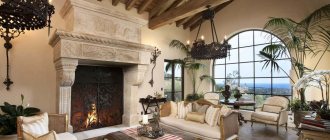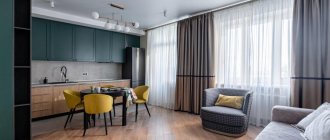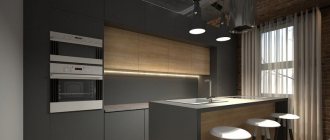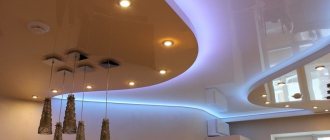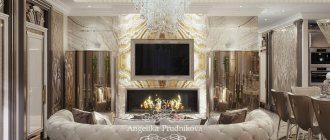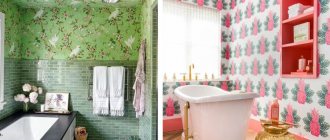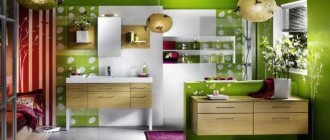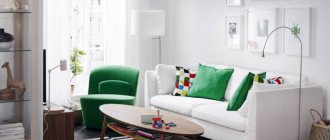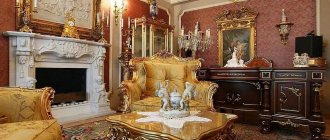The constructivist style originated in the 30s of the twentieth century. In architecture and interior design, there is an urgent need for a functional, simple and practical style direction. Designers supported this idea, in turn, adding a special aesthetic to constructivism. Today it is the most popular among style trends.
Living room-kitchen in constructivist style
The dominant feature of constructivism is its extreme rationalism in everything, no ornate ornaments, complex patterns or intricate lines. The essence of constructivism lies in the rigor of geometric shapes, the clarity of color separation and, of course, the practicality of materials.
Increasingly, active youth, striving to subordinate their lives to a certain routine, give preference to constructivism, while absolutely not depriving themselves of the right to originality. The restraint of the situation is not evidence of stinginess, either material or psychological. On the contrary, this is an indicator of the high spiritual world of the apartment owners.
Black and gray interior in constructivist style
Beige and brown living room in constructivist style
General characteristics of the style
The decor in constructivism is not just extremely restrained; it strives to absolutely avoid haphazardness and unnecessary diversity. This style served as the basis for a branch of such a style as hi-tech. Its main goal is versatility of possibilities, while maintaining the overall rigor of lines and forms, which is easily achieved with the help of effective constructivism in furniture production, as well as newfangled built-in furniture of the latest models.
Living room with fireplace in constructivist style
Living room-kitchen in a house in the constructivist style
Two-story building in constructivist style
Beige wall in the living room in the constructivist style
Spacious living room in constructivist style
Features of the constructivism style
The constructivist style originated in the thirties of the twentieth century. The basis of constructivism is rationalism and practicality. This idea arose in contrast to the foundations of Tsarist Russia. Post-revolutionary society wanted to isolate itself completely from the bourgeois past and, in defiance of the “philistine” interior design, create a completely new one - functional and simple.
Proletarian constructivism appeared as a Russian echo of the avant-garde style that was gaining popularity in Europe in those years. This direction in the design of premises puts the design, rather than the composition, to the fore. The style arose as an experiment, which makes it possible to create something unusual, new, without pretentiousness or embellishment.
Laconic shapes, light shades, large space - all this corresponds to the chosen design
Many adherents of this style think clearly and express their opinions in a similar way: “A bed is only needed for relaxation, why decorate it with gold elements or stucco?” They consider all decor that has no practical use to be unnecessary.
The main features of constructivism in the interior:
- laconicism of forms;
- lack of ornateness;
- clear color separation;
- strict geometry of forms;
- use of practical materials;
- rationalism;
- simplicity.
Other similar design trends - minimalism, high-tech - also take their origins from constructivism.
Particular attention should be paid to Soviet constructivism, which appeared as a government order. The red thread of this idea was the socialist community. Working common people took over the premises of the former bourgeoisie and made their own “amendments” to the interior in the form of simplification, getting rid of luxury, and eliminating any hint of decor.
Factory-made, mass-produced furniture, uniform arrangement of rooms, standard design of the interior of housing, lack of individual items, getting rid of “philistine” things (figurines, napkins, etc.) - all this became the slogan for Soviet people for many years.
The room looked ascetic and uninteresting in the era of Soviet constructivism
Modern constructivism has surpassed the Soviet understanding of this style as something simplified and faceless. With the help of constructivism, you can express your individuality depending on your ideas and material capabilities.
Lighting
Constructivism primarily values natural lighting. Large window openings cope well with this task. Therefore, here, panoramic windows or floor-to-ceiling windows, a large window with a door and the possibility of exiting to a terrace or balcony, will come in handy. Curtains are an absolute taboo for this style; in extreme cases, you can hang light blinds or roller blinds. When distributing artificial light, the main requirement will be its expediency.
Black and white living room in constructivist style
A chandelier, like all other lighting fixtures, should be located where they are most needed, where you cannot do without them. Lamps, chandeliers and sconces must have only the correct geometric shape, without overkill or excessive pathos.
Chandelier and spotlights in the living room-kitchen in the constructivist style
Spot lighting in the living room with a fireplace in constructivist style
Black chandeliers in the dining room in the constructivist style
Lighting above the apron in the interior of a kitchen in the constructivist style
Constructivism in the bathroom
It is better to choose a rectangular shape for the bath, toilet and sink. It is not recommended to place anything else in this room. Faucets and fittings should have a laconic design, right angles are encouraged. The mirror can be hung in a simple, strict frame or without one at all.
USEFUL INFORMATION: Ideas for a small children's room
The constructivist style is suitable for hard-working people who are in search of themselves. It encourages self-analysis and self-development. Therefore, it is chosen by researchers, experimenters and scientists. This style is well suited for small spaces, it does not clutter them.
Color scheme in the style of constructivism
Typically, the color palette of constructivism is dominated by monotony. At the same time, the right to bold and bright accents is retained. The most popular options: a combination of light gray or white with black, red, dark gray, light green. As a rule, three shades can dominate; too much can deprive the interior of its integrity. Stonework or wood pattern in the constructivist style will look more like aliens; instead of the intended main background, they will become a separate bright and completely undesirable object.
Black, brown and white colors in the interior in the constructivist style
Brown-gray interior in constructivist style
White interiors in constructivism style
White and brown interior in constructivist style
Multi-colored accents in a cozy living room in the constructivist style
Materials and finishing
The advantages of the style include low financial costs when creating an interior and the availability of materials to any consumer. These factors are often decisive, especially if you value convenience above all and do not like to clutter the room with unnecessary things. Constructivism is not characterized by the embellishment inherent in other popular styles, such as Art Nouveau, Rococo and Classical.
Constructivism allows you to implement bold ideas not through pompous forms and expensive furnishings, but through playing with space and using the latest construction and finishing materials.
The ceiling and walls do not need to be decorated; they are often concrete bases and painted plaster, the base color being white. The floor is most often made of wood; if it is tile, then it is plain, preferably gray, white or black.
The colors in the interior of the constructivism style are pure, without shades: black, white, red, blue and yellow. It is from their combination that accents are made and functional areas in the room are emphasized. Interestingly, this interior style is rarely seen in private homes. It is rather a tribute to urbanization, an integral part of concrete buildings.
The entire interior should create the illusion of a clean, open and bright space. This is achieved through a minimum number of things and proper zoning.
Decoration Materials
Constructivism will not require large financial investments from you, since the most inexpensive materials such as glass, plastic and metal are used for the interior. After all, the main goal of style is not appearance, but meeting the real needs of the customer. The aesthetic side of constructivism is quite extraordinary. Notes of elegance, however, can be traced, they are introduced by glass surfaces, chrome details, extravagant textiles, as well as bright accents. Laconism in everything is characteristic only of independent styles, such as constructivism.
Laminate and paint in the living room decoration in the constructivist style
Black walls in the living room in constructivist style
White walls in a relaxation area with a swimming pool
Multi-colored walls in the living room in constructivist style
Striped bright wallpaper in the office in the constructivist style
Constructivist decoration of walls, floors and ceilings
The walls should be smooth, preferably simply painted, without any decorative finishing. You can decorate them with an abstract pattern using 2-3 colors. The design itself should be extremely simple: large rectangles, circles, a wide stripe.
You can put up wallpaper, but it should be plain, without a prominent texture.
The pattern of the walls should be repeated on the ceiling. For example, it could be a bright stripe that goes from the ceiling to the wall. The main color of the walls and ceiling is white. You can use suspended ceilings to create a smooth, even surface. If the ceilings are high, then you can use plasterboard to create a three-dimensional geometric structure.
USEFUL INFORMATION: Modern bathrooms: design, photos
Light or dark laminate is usually laid on the floor. It should be either almost white or close to black. Light tiles are used in the kitchen.
Space division
The ideal distribution of free space in constructivism excludes dividing it into rooms; it only implies zoning the room using furniture and a color palette. Well, the most characteristic aspect of this style is empty space filled with daylight, minimalism and a lot of air.
Division of space in the kitchen-dining room in the constructivist style
Brown-orange kitchen in constructivist style
Dining room in a house in the constructivist style
Kitchen-dining room in constructivist style
Studio apartment in constructivist style
Lighting
This style is characterized by its affinity for natural light. This is precisely the reason for the large amount of glass in the interior. Window profiles are made as large as possible, preferably from floor to ceiling.
Textiles should be kept to a minimum. Nothing should block the sunlight.
As for artificial lighting devices, they are placed in those places where you cannot do without them. There should not be any large chandeliers covering the entire ceiling. It is advisable that the light bulbs are also built into the ceiling or furniture profile.
The acceptable shape of the lamp is a strict geometric shape, without unnecessary decorative elements. If small LED bulbs are used, the lighting lines should continue the clear edges of the room.
Instead of textiles, it is better to use minimalist blinds or strict one-color Roman blinds.
Furniture and its background
In this matter, one cannot underestimate the merit of furniture and its correct arrangement, thanks to which it becomes monolithic, as if it is one with the room. Cabinet furniture seems to grow out of the walls, and tables and upholstered furniture smoothly grow into the floor. This effect is achievable through the use of clear, geometrically correct lines and shapes, and by maintaining one primary color.
A minimum of furniture in a room in the constructivist style.
In pre-war times, people treated furniture as a luxury. And for good reason, because it was decorated as best they could with all kinds of carvings and the most extravagant ornaments. The constructivists of that era offered a completely different view of pieces of furniture, discarding everything related to the aesthetic side, leaving only their direct purpose. Since production at that time was maximally overloaded, given that after the war and revolutions, many people lost their homes, not to mention the household side of the economy. Therefore, the people needed the most basic things: they needed a chair, a table and a bed. Mass production became possible only after a global change in the product itself, no stucco or decorative details. Furniture became just furniture. And it carried only a functional load. In the modern world, constructivism is easily recognizable by the countless shelves along the walls and the nakedness of the structures.
Gray and white living room in constructivist style
Brown and gray furniture in the interior in the constructivist style
White shelves in constructivist style
Black and white bathroom furniture in constructivist style
Children's
Constructivism is rarely used to decorate a children's room. A child may find such a room too boring, but the style also has its advantages. Taking into account children's needs, growing every year, the character of a baby in practical conditions can be formed according to a completely different model. Naturally, there will be more bright accents in the room than in other rooms. As an exception, the presence of a pattern is allowed: geometric shapes and their combinations. The entire minimum furniture fits in one corner: a “loft” bed with a storage area and a workplace.
Ceiling
Modern constructivism is not very different from the style of the 20s and 30s; its main slogan still sounds like “minimalism and rigor.” But the ceiling has undergone some modifications. In those days, they could not boast of a suspended ceiling or a plasterboard ceiling, especially a multi-level one. But actually this is not surprising, because progress has not yet reached the level of constructivism of that time.
Black ceiling in the kitchen with an island in the constructivist style
Red, gray and white colors in the living room in the constructivist style
White ceiling in the living room in constructivist style
Multi-colored ceiling in the living room in the constructivist style
White ceiling in the living-dining room in constructivist style
History of origin
Many design trends were born in the first half of the 20th century. Some of them are a product of changing historical eras. When the Russian Empire fell and the USSR was formed, a completely different society of people appeared with different ideas about life and reality. They denied everything that happened before. A message was formed to search for new forms in everything: in painting, in literature, in architecture.
Constructivism was born in the USSR Source yandex.net
Pure art found itself in opposition. The workers and peasants who were in power had no use for it. Utilitarianism came first. A new term “production art” has appeared. From now on, people of creative professions had to create useful and convenient things. At the same time, it was necessary to glorify the new government. For this purpose, monumental buildings, cultural palaces and clubs were erected. Constructivism became the style of the ruling power.
Palaces of culture of the 30s Source twimg.com
They had a restrained appearance; there were no decorative elements on the facades or inside the premises. Everything: both the appearance and the internal content should be perceived as a single clean space. It did not divide in any way, it remained open. Many then found it boring and uninteresting. But the style stuck. Today it is actively used in the design of modern interiors. He has the same characteristic features. Knowledge about them helps to recreate constructivism in residential design with great accuracy.
Large space with a minimal amount of decor Source yandex.net
Who is this interior style suitable for?
In an apartment with this style, the owners will not have to rest; constructivism, on the contrary, sets up and even inspires the work process. In addition, the environment will little by little lead you to the desire for self-knowledge and the development of personal qualities and character traits.
Swimming pool in a house in the constructivist style
The next type of people for whom the constructivist style will be close are great researchers, restless experimenters or scientists. A huge advantage of this experiment is its low cost.
The style works well in rooms of any size, even the smallest. Its main advantage is its brevity and simplicity; these simple qualities will allow you to breathe life into the most cramped and shabby space, filling its image with light and comfort.
Fashionable kitchen with an island in constructivist style
White bathroom in constructivist style
Bright accents in the living room with a fireplace in constructivist style
Black and white modern kitchen in constructivist style
Constructivism in the interior of the hallway
Who will say that there is not enough space in the hallway? A large five-door wardrobe can accommodate a lot of things. Mirrors and glass doors will add volume to the room
In most homes, the hallway is a small room without windows. The space is visually enlarged due to light walls. They install spacious cabinets up to the ceiling with mirrors or colored glass doors. Add a bright accent (this could be a banquette with red upholstery or a mirror in a bright plain frame on the wall).
In addition to the chandelier, they attach a lamp above the mirror or make a built-in lighting in the canopy above the cabinet. A tiled floor will not only maintain the concept of the room, but will also make it easy to remove dirt brought on shoes from the street.
